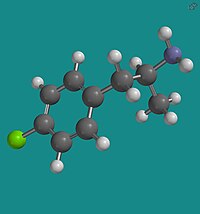para-Chloroamphetamine
 | |
 | |
| Clinical data | |
|---|---|
| Other names | PCA; 4-Chloroamphetamine; 4-CA |
| Legal status | |
| Legal status | |
| Identifiers | |
| |
JSmol) | |
| |
| |
| | |
para-Chloroamphetamine (PCA), also known as 4-chloroamphetamine (4-CA), is a
para-Chloroamphetamine has been detected as an apparent designer drug,[6] along with the related 3-chloroamphetamine, which is even more potent as a releaser of dopamine and serotonin but slightly less neurotoxic.[7][8][9][10][11]
The closely related N-methylated derivative, para-chloromethamphetamine (CMA), which is metabolized to para-chloroamphetamine in vivo, has neurotoxic properties as well.
Legal status
China
As of October 2015, 4-CA is a controlled substance in China.[12]
See also
- Substituted amphetamines
- para-Chloromethamphetamine (4-CMA)
- Chlorphentermine
- 3,4-Dichloroamphetamine (DCA)
- 4-Fluoroamphetamine (4-FA)
- 4-Methylamphetamine (4-MA)
- 5,7-Dihydroxytryptamine (5,7-DHT)
- para-Bromoamphetamine (PBA)
- para-Iodoamphetamine (PIA)
References
- PMID 3707603.
- S2CID 1068793.
- PMID 80243.
- PMID 7682129.
- PMID 8602894.
- PMID 21513613.
- PMID 5029422.
- PMID 303437.
- PMID 474143.
- S2CID 41833796.
- PMID 579062.
- ^ "关于印发《非药用类麻醉药品和精神药品列管办法》的通知" (in Chinese). China Food and Drug Administration. 27 September 2015. Archived from the original on 1 October 2015. Retrieved 1 October 2015.
